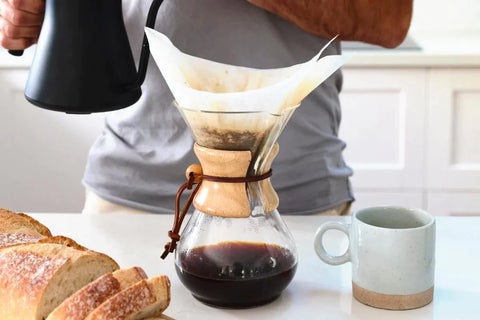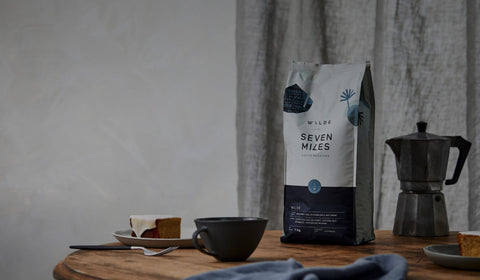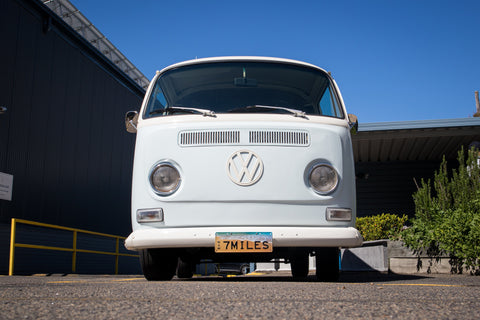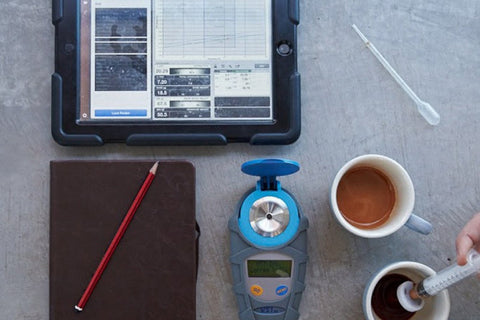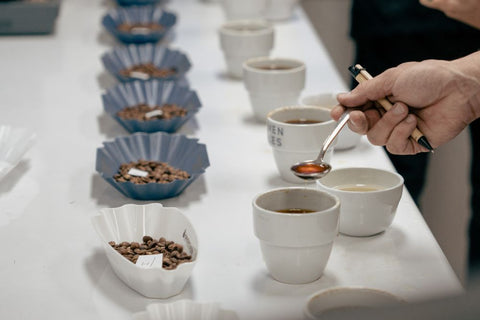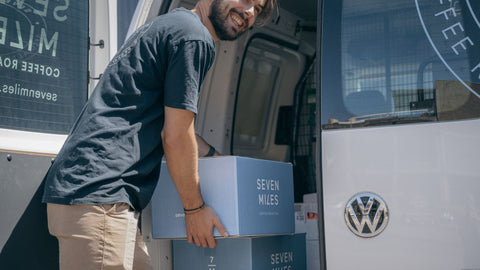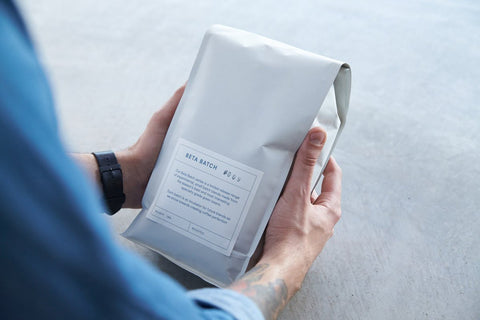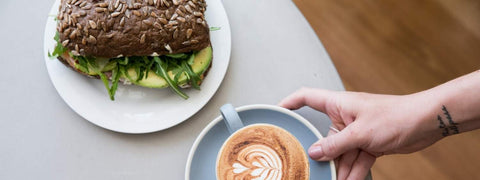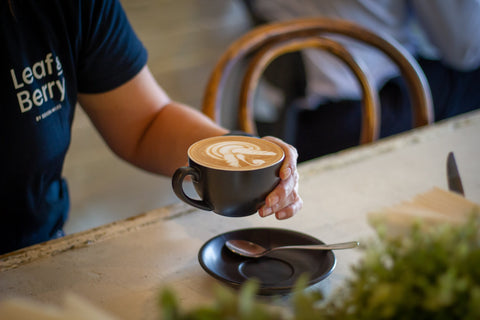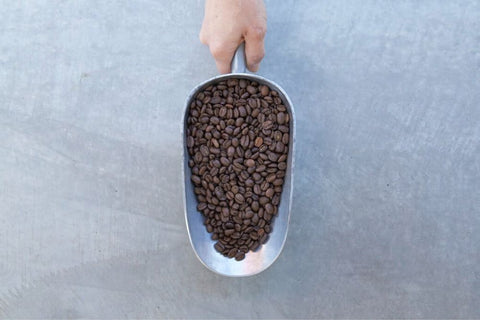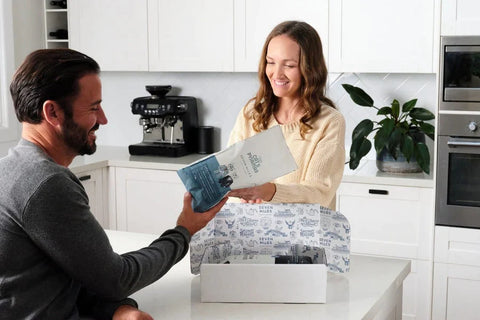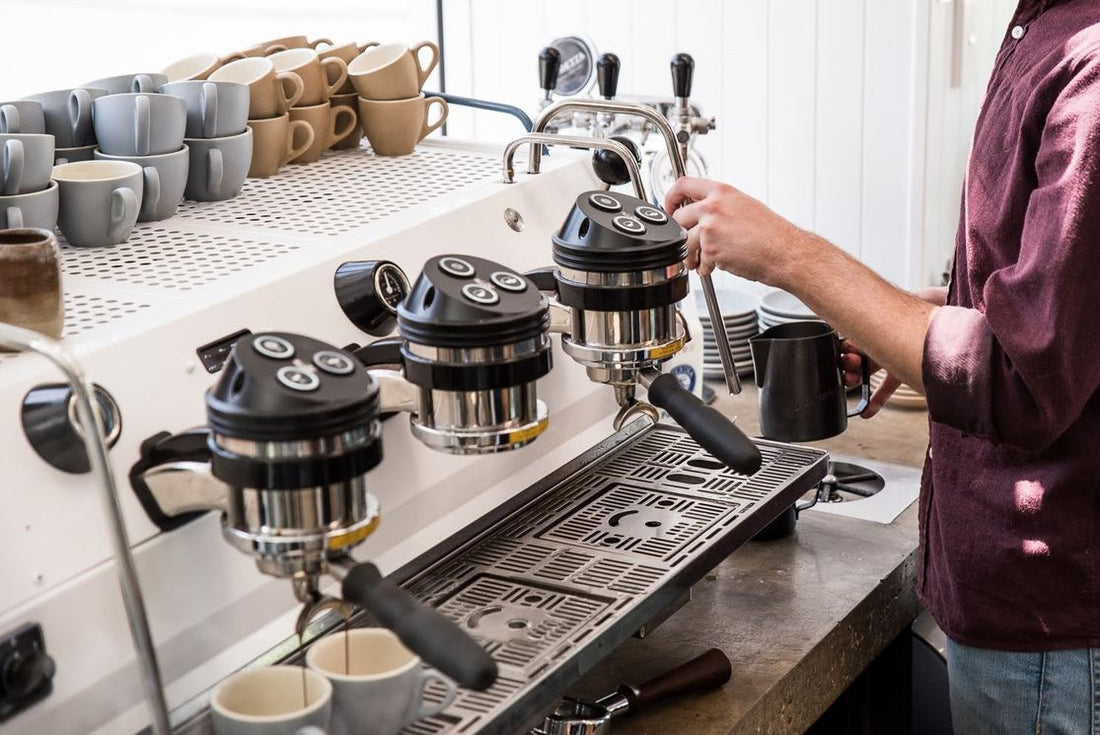Choosing a commercial espresso machine for your café, restaurant or espresso bar can be a daunting task. With so many different machines on the market, how do you know which features are right for you? How much do you need to spend? Should you prioritise function or style? It’s the heels vs flats dilemma of the coffee world.
Ok, let’s clarify something up front: We don’t actually sell machines. We do, however, buy a wide range of commercial espresso machines & grinders that we supply on-loan or as a rental to our café customers. So, we do know a thing or two about what works and what doesn’t in a café environment.
What to look for in a commercial espresso machine
We’ve broken it down into what we think are some of the most important factors to consider when choosing a machine.
Click below to jump to key sections of this article:
- Workflow & Automation
- Style
- Reliability & Servicing
- Buy, Lease or ‘On Loan’. What are the options?
- How Much Does A Commercial Coffee Machine Cost?
- Our Recommendations
Capacity
There are two main types of commercial espresso machine – heat exchange or multi boiler.
Heat Exchange Machine
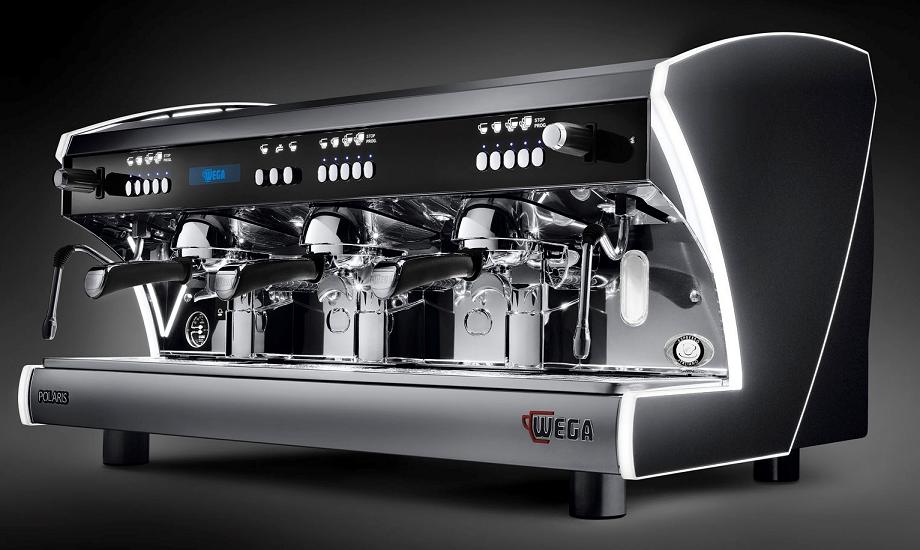
The Wega Polaris is an example of a heat exchange machine. Pic: CWE
A heat exchange machine has a single steam boiler, with copper pipe that runs through it called a ‘heat exchanger’. As the name suggests, the water running through the heat exchanger is heated by the high temperature of the steam boiler. This water then goes to the group head and is used to brew the coffee.
A heat exchange machine is best suited for restaurants, offices, or smaller cafes where coffee making is steady throughout the day, rather than in rushes. Heat exchange machines also tend to be smaller in size, as they only need to house one boiler, so they’re a great option when space is tight.
2. Multi Boiler Machine

The Sanremo Cafe Racer is an example of a multi-boiler machine. Pic: Sanremo
A multi boiler machine has a minimum of two boilers. One large boiler at a higher temperature for producing steam and one at a lower temperature for brewing coffee (some machines even have an individual boiler for each group head).
The benefit of a multi-boiler machine is that you have direct control over the temperature of the water used to brew the coffee. This type of machine can also be more temperature stable as the group head temperature is not affected by the temperature in the steam boiler. This results in a more consistent flavour in the cup.
Power
One thing to remember when selecting a machine is the power requirement – the more functions and features the machines has, the more power the machine will require. A heat exchange machine usually ranges from 15-25amp depending on the number of groups, while a multi-boiler can require up to 40amp.
Groups
The other big decision is around how many group heads you need. The most common choices are either 2 or 3 group machines as these fit most businesses and coffee volumes.
As a general rule, a 2-group machine will happily make up to 20kg coffee per week. Above 20kg of coffee per week is where we generally recommend a 3-group espresso machine which can manage volumes anywhere up to 100kg per week.

Depending on your cup sizes, each "group" on an espresso machine can brew 2 small or 1 large coffee at a time.
“What about a 4 group” I hear you ask, surely more is more? Unless you have multiple baristas on the machine at once, the 4th group won’t serve you too much of a benefit as a single barista often cannot keep up with the demand. If you’re in 4 group territory, I’d suggest opting for two, 2 group machines as a safeguard in the event of a breakdown.
Workflow & Automation
Shot timers, scales, volumetrics, auto brew ratios, levers – these are some of the buzz words you will hear when talking about the latest espresso machines. Features like these are great, if you actually use them. This is a business, and the goal here is to improve quality, consistency & efficiency.
Volumetrics
The most basic form of automation is what’s known as ‘volumetrics’ – these are the programmable touch pads found on most machines allowing you to set different doses for each of your different coffee sizes. This is controlled by a flowmeter which delivers a set volume of water each time you hit the button.

Basic volumetric controls & a shot timer are simple but effective quality control tools
Gravimetrics
The next step from here is ‘gravimetrics’ - these are machines which have scales built in to the drip tray. This means you can program your shots by weight, rather than by volume. Measuring by weight provides a more accurate dose, which in turn delivers a more consistent flavour in the cup.
Auto Brew Ratio
You can then step it up even further with machines like the La Marzocco Strada ABR which adds auto brew ratio technology to its built-in scales. With this system, you tell the machine your desired brew ratio (e.g. 1:2).
You then use the scale in the machine to weigh the coffee-filled group handle (e.g. 20g) and then the machine will dispense water until your set ratio is reached (e.g. 40g of brewed beverage, giving us a 1:2 ratio).
Other Features
Automatic cleaning cycles and night-mode (also known as eco-mode) are some other useful features that can save you time and money by reducing labour and electricity respectively. Night-mode automatically lowers the temperature of the boiler during long gaps in service (like overnight), which saves power while the machine is idle. It also means that in the morning, the machine will heat up much faster as it is not heating from completely cold.
It’s also important to consider ergonomics. You’re going to be standing behind the machines for hours at a time, so you want it to be comfortable and easy to use, putting as little strain on your body as possible. Features like push/pull or quarter turn steam levers, rather than traditional twist knobs are a plus as it means less repetitive strain on the wrist when steaming milk.
The launch of the La Marzocco KB90 in 2019 added a new angle to barista ergonomics by introducing 'straight-in' group heads. These do away with the repetitive twisting motion needed to lock in traditional portafilters. It seems like a small thing, but when you're doing it hundreds of times a day, the strain can add up.
If you want to get extra fancy, you can start thinking about automatic pressure profiling, which increases/decreases the pump pressure throughout the shot to allow you to manipulate the flavour. Some machines with this function will allow you to save your profile so that it can be replicated shot after shot for some interesting flavours.
Automation Accessories
The more basic tasks you can automate, the more time you will have to interact with your customers. Consider pairing your machine with an electronic grinder, a Puqpress and an Ubermilk and you’ll have a seriously efficient coffee set up and some very happily caffeinated customers.Same barista, same coffee order. On the left is using manual processes, the right is semi-automated using the Puqpress, La Marzocco ABR (gravimetric) & Ubermilk. Note the differences in eye contact and conversation.
While all the above features are very cool to play with, don’t get too starry eyed during the selection process and make sure you’re only buying a machine with features that you are going to use.
There is no need to spend tens of thousands of dollars on the top of the line coffee machine if you’re going to be slinging espresso the old school way. Think about which features are the most important to your business and which ones will help you achieve the results you’re after.
Style
We can talk about temperature stability and brew ratios all day long, but what does the machine look like?
The more traditional machines, like the La Marzocco Linea Classic, have a simple, functional stainless-steel look, designed to blend into the coffee bar rather than stand out. While the more high-end machines, like the Sanremo Opera 2.0, are designed to make a statement, showing your customers that you take your coffee very seriously.
These days, many cafes choose to customise the panels of their espresso machine to give their classic machine a unique twist. Most machine panels can be easily removed, allowing you to take them down to your local spray painter or powder coater and have them painted any colour you choose. Another affordable option is vinyl wrapping, which allows you to apply an image to the machine panel, rather than a solid colour. These options usually cost between $300-1,000 depending on the details.
If you have the budget and you want your machine to be really unique, there are companies who do some incredible custom work on machines. We’re talking custom logos, laser cut panels, timber work, you name it… Customisation at this level could set you back around $5,000 depending on the details you choose.
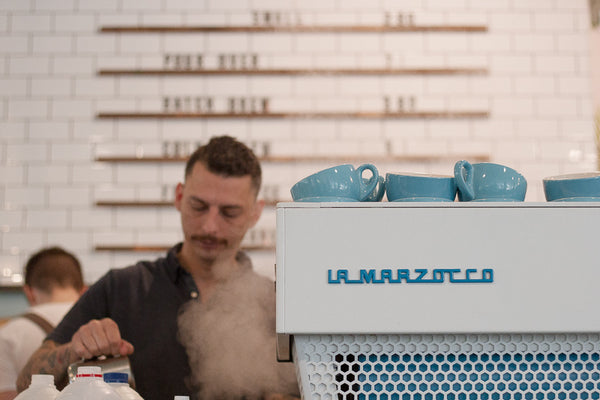
La Marzocco Linea Classic with custom colours and panels
Reliability & Servicing
Servicing is something that often gets overlooked when deciding on a machine. No matter how expensive the machine, at some stage, it’s going to need repairs.
Think of it like your car; it will need a general service approximately every 6 months, where perishable parts like group seals, washers & shower screens will need to be replaced. Also, every 1-2 years it will need a major service where the internals will be checked, cleaned and parts replaced. The good news is that there are ample service technicians who can keep your machine running smoothly. City areas will have more techs than regional areas; so be sure to find out who your local tech is before purchasing a machine.
That way, you can make sure they carry parts for the machine you are thinking of purchasing. With high-end machines; parts are often brand specific, so make sure genuine parts are used to avoid issues down the track.
Water
Water quality is a critical factor for the reliability of the machine & the taste of your coffee. In some areas, all that’s needed is a simple carbon filter. While in other areas, custom scale-inhibitors or reverse-osmosis systems might be needed to get this right. The only way to tell for sure is to get the water tested.
Your service technician (or one of our local coffee pros) can test the water and recommend a suitable water filter for your machine, as well as how often it will need to be replaced.
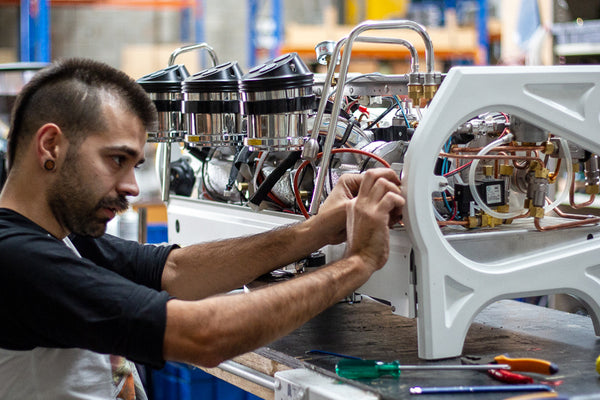
A commercial espresso machine is more like a car than a toaster. It will let you down if it's not regularly maintained.
Buy, Lease or ‘On Loan’. What are the options?
There are 3 options when it comes to finance:
Buy outright
Using your own finance (or cash). The benefit is flexibility: no repayments or agreements. The downside is that your cash tied up in a depreciating asset. You'll also have to maintain the equipment yourself.
Lease
Specialty finance companies like Silverchef or FlexiCommercial can lease the equipment to you. The benefit is the up-front saving, and some flexibility to pay out the lease at the end of the term. The downside is the interest rates are typically quite a bit higher than an old-fashioned bank loan… and you still have to maintain the equipment.
Loan (or rental) from your coffee roaster
This works a bit like a typical mobile phone plan. The coffee roaster provides the equipment as part of an agreement – you buy coffee from them, they supply & maintain the equipment. The benefit is the up-front saving, and that they need to service and maintain the equipment. The downside is that the equipment cost is built in to the price of the coffee.
“On Loan” equipment sometimes gets a bad reputation in the industry. For me, this all comes down to who you choose to partner with and what they can offer. Can I finance this equipment myself at a lower cost? Do they have a good track record of support? What happens if I sell the business?
How Much Does A Commercial Coffee Machine Cost?
Good quality, entry level heat exchange machines range from $4,000 to $10,000. While multi-boiler machines range from $10,000 all the way up to $40,000. Unless you’re after something with all the features, you’ll be able to get a quality, multi-boiler machine, like the La Marzocco Linea Classic for under $15,000.
Our Recommendations
The most popular commercial espresso machines in Australian cafes over the last few years are undoubtedly the La Marzocco Linea Classic & Linea PB. It’s easy to see why: they’re precise, well-made, and the brand has a cool factor that is widely recognised. Yes, it’s a great machine, but is it right for you?
Other machines in the same multi-boiler category worth considering are the Victoria Arduino Black Eagle & Sanremo Opera 2.0. These machines all have a minimum of 2 boilers and are very temperature stable. They both have automatic cleaning cycles, shot timers, and the option of built-in scales in the drip tray.
If you’re simply looking for a reliable, workhorse that won’t let you down, some of our main go-to machines are the Unic Mira, Wega Polaris & Nuova Simonelli Appia II. These machines are more traditionally shaped, they’re all heat exchange, and they all smash out some great coffees. Features you’ll find on these machines are shot timers, auto cleaning cycle, volumetric controls and they're easy to service.
For something completely different - if you want to take it back to the future with a traditional, hands on machine, you may like the La Marzocco Leva. It’s delivers a new school level of deliciousness in an old school, grungy body.
What is the best Commercial Coffee Machine?
Our recommendations:- La Marzocco Linea PB
- Dalla Corte Icon
- Sanremo Cafe Racer
- Victoria Arduino Black Eagle
- Wega Polaris
Also comparing grinders? Take a look at our guide to 5 of the best commercial espresso grinders. For those getting started in the cafe business, check out our guides to opening a cafe & buying a cafe. Or read more about how we support cafe business
